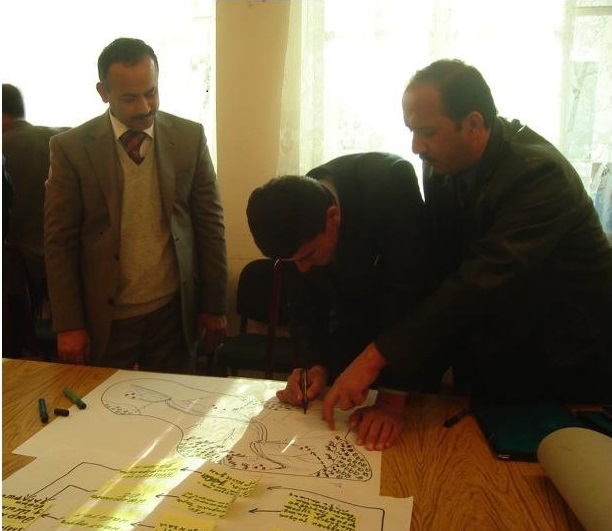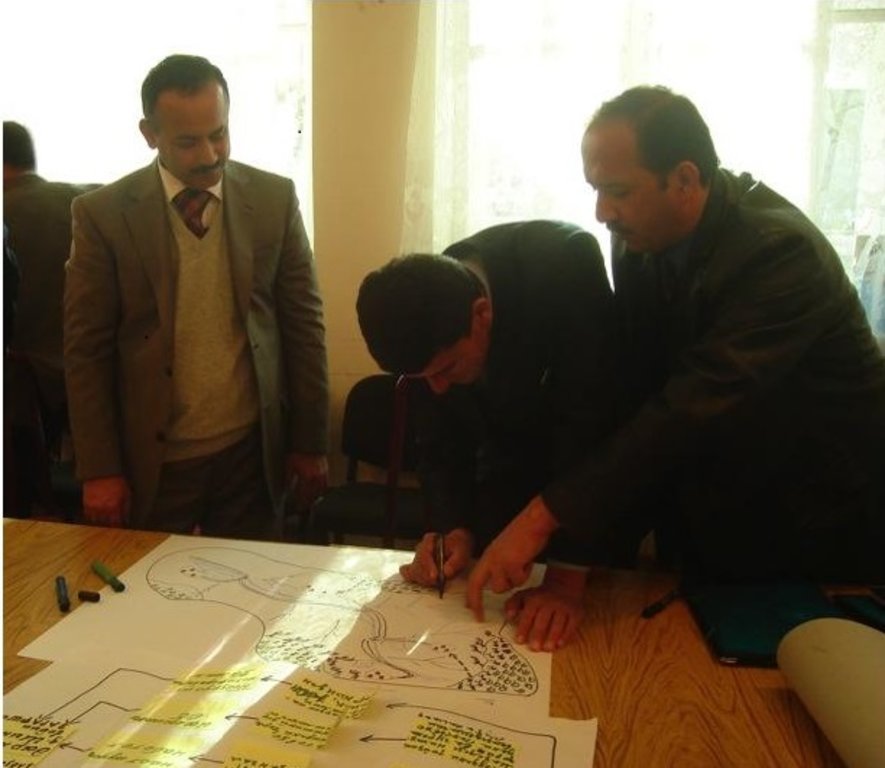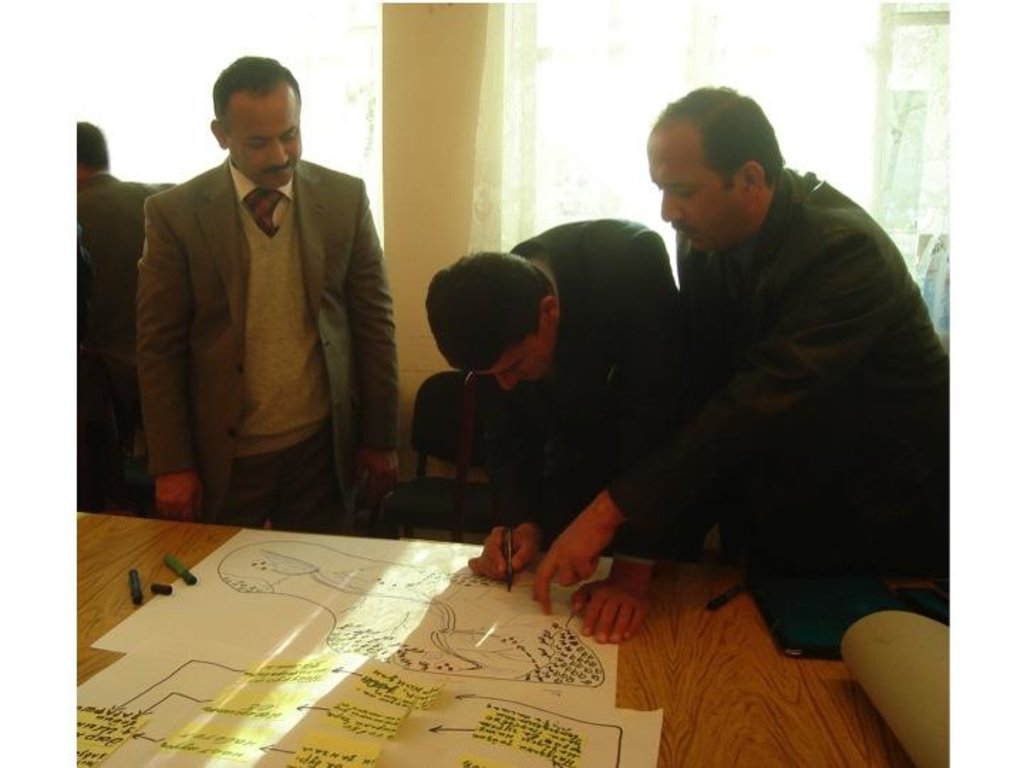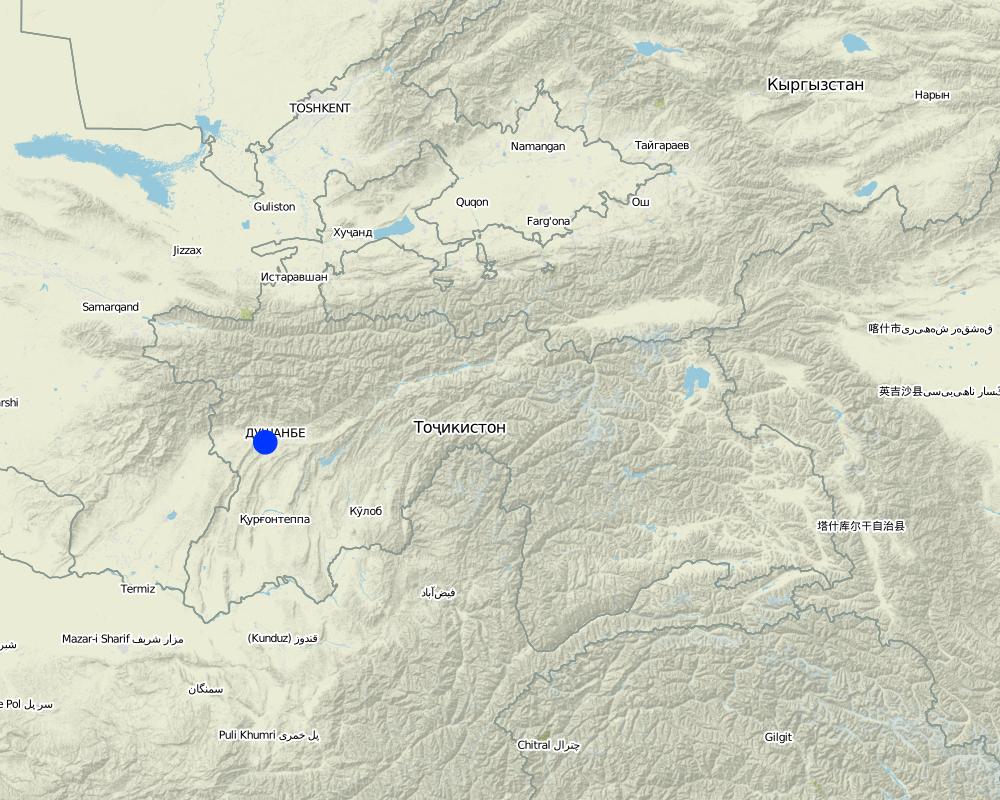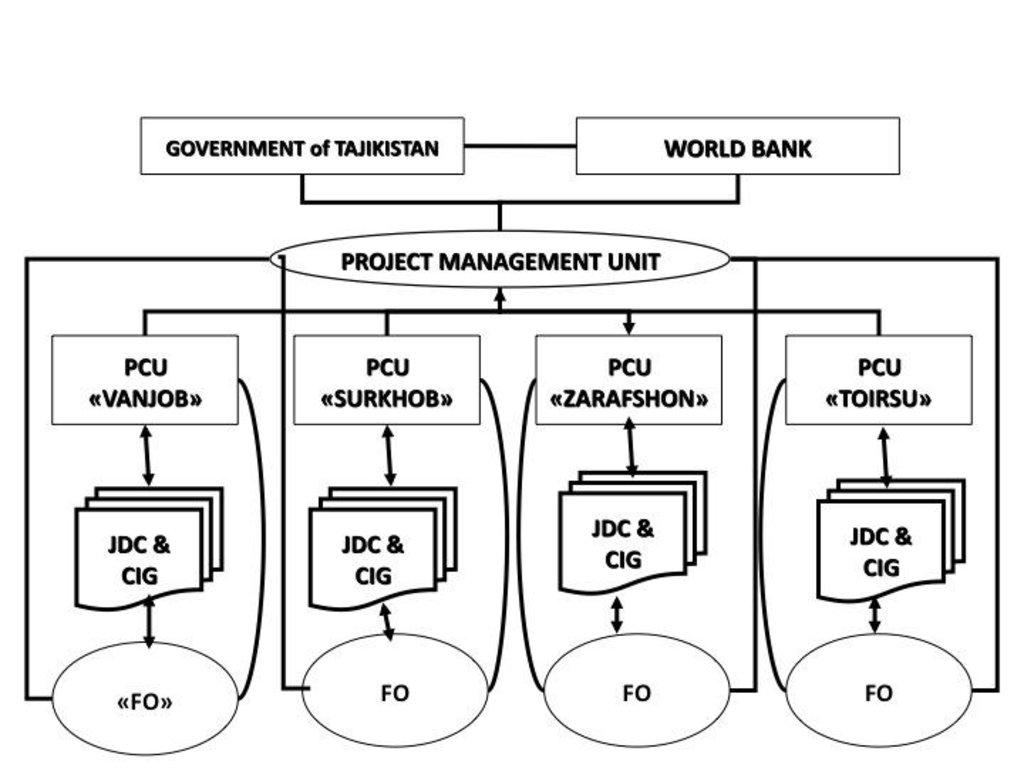Eligibility Criteria and Environmental Planning Tools for SLM [塔吉克斯坦]
- 创建:
- 更新:
- 编制者: Nandita Jain
- 编辑者: –
- 审查者: David Streiff, Alexandra Gavilano
approaches_2578 - 塔吉克斯坦
- Eligibility Criteria and Environmental Planning Tools for SLM: July 7, 2017 (inactive)
- Eligibility Criteria and Environmental Planning Tools for SLM: July 7, 2017 (inactive)
- Eligibility Criteria and Environmental Planning Tools for SLM: Aug. 10, 2017 (inactive)
- Eligibility Criteria and Environmental Planning Tools for SLM: Nov. 2, 2021 (public)
查看章节
全部展开 全部收起1. 一般信息
1.2 参与方法评估和文件编制的资源人员和机构的联系方式
SLM专业人员:
Mott Jessica
World Bank
美国
有助于对方法进行记录/评估的机构名称(如相关)
World Bank (World Bank) - 美国1.3 关于使用通过WOCAT记录的数据的条件
(现场)数据是什么时候汇编的?:
19/11/2007
编制者和关键资源人员接受有关使用通过WOCAT记录数据的条件。:
是
1.4 SLM技术问卷的参考
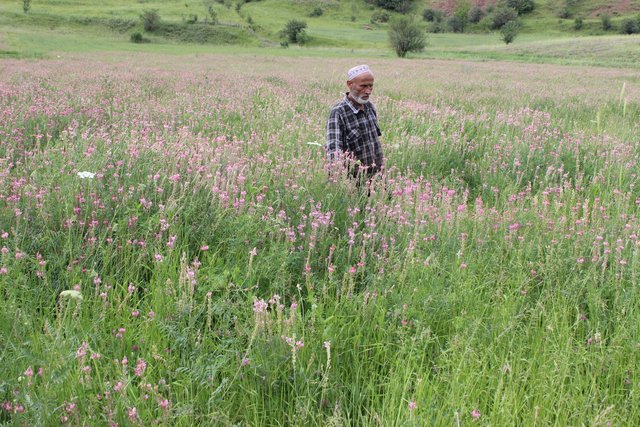
[塔吉克斯坦]
None
- 编制者: MIZROBSHO AMIRBEKOV
2. SLM方法的描述
2.1 该方法的简要说明
Using eligibility criteria and participatory environmental analyses for selecting and assessing SLM investments.
2.2 该方法的详细说明
该方法的详细说明:
Aims / objectives: As part of the Community Agriculture and Watershed Management Project (CAWMP), tools were developed to ensure farmers chose appropriate SLM technologies while preparing Community Action Plans (CAPs) and to improve environmental assessments during CAP preparation and in rural investment activities.
Methods: Eligibility Criteria: CAWMP financed small grants for three types of rural production investments: farm productivity, rural infrastructure, and land resource management (the largest type). The eligibility criteria for these grants included meeting at least one of the following impacts on fragile lands: • Prevent/reduce soil erosion • Increase vegetative cover through perennial crops and pasture • Provide soil and moisture conservation • Improve soil quality • Improve water use efficiency • Increase sustainable fodder/wood supply • Increase sustainable renewable energy supply • Increase integrated pest management These criteria ensured an environmental focus, and kept the grant proposals consistent with a list of eligible activities which is critical for a large-scale, community-driven project such as CAWMP. The criteria helped avoid diversion of grant funds to investments not directly related to land sustainability. Combining income-generating investments with environmental criteria encouraged sustainable land use by addressing vital interests of local people. The criteria were used to monitor local environmental impacts. Project arrangements provided for land use right certificates to beneficiaries with Project-financed investments on sloping lands, giving them a stake in the sustained productivity of their land. Traditionally such land use right certificates were issued only for irrigated and other valley areas. The Project financed a total of almost US$ 5.3 million in grants for land resource management, through almost 2,300 subprojects, benefitting over 43,000 households.
Stages of implementation: Participatory environmental analyses. A review of investment proposals and field activities in 2007 revealed that farmers were not capable of properly assessing their local land management problems, identifying the most environmentally appropriate investments or actions, nor monitoring their effectiveness. Tools were developed for project partners and officials to address these concerns including: 1) Developing Conceptual Models of Local Environments/Watersheds; 2) Mapping Local Environments/Watersheds and Associated Threats; 3) Identifying and Ranking Environmental Threats; and 4) Community Environmental Assessment. More than 50 persons attended the two-day interactive training course on the use of the tools. Detailed guidelines for facilitators and trainers to use the tools were prepared in Tajik and Russian. While the training could not influence many of the SLM-related investments already submitted for funding, participants urged that similar training be conducted at the inception of SLM-related projects and that the tools be requirements of SLM planning.
2.3 该方法的照片
2.5 采用该方法的国家/地区/地点
国家:
塔吉克斯坦
区域/州/省:
Sughd, RRS, Khatlon, GBAO
有关地点的进一步说明:
Jirgital, Tajikibad, Vanj, Aini, Matcha, Penjikent, Danghara
注释:
The Community Agriculture and Watershed Management Project was implemented in four project sites/watersheds - Surkhob, Toirsu, Vanjob and Zarafshan - and included 7 districts/raions and 39 sub-districts/jamoats. The total catchment area was 35,000km2. Total arable, farm and pasture land was approximately 319,500ha
Map
×2.6 该方法的开始和终止日期
注明开始年份:
2005
终止年份(若不再采用该方法):
2012
2.7 方法的类型
- 基于项目/方案
2.8 该方法的主要目的/目标
The Approach focused mainly on other activities than SLM (participatory environmental analyses, eligibility criteria, monitoring, assessment, training, guidelines, )
Application of the criteria and tools to help ensure that proposed rural investments in Community Action Plans kept their environmental management focus.
The SLM Approach addressed the following problems: Inappropriate investments with questionable SLM benefits proposed in CAPs. Uneven, sometimes, missing focus on environmental risks and benefits in small grant proposals for rural production investments. Lack of skills in and knowledge of participatory environmental appraisals.
2.9 推动或妨碍实施本办法所适用的技术的条件
机构设置
- 阻碍
Legacy of command-economy focus on infrastructure investments for improving land management and agriculture
Treatment through the SLM Approach: Tools to analyse a range of environmental aspects of land management and propose alternative technologies and approaches, training for project implementers and stakeholders.
了解SLM,获得技术支持
- 阻碍
Lack of appropriate analyses of environmental relationships, threats, risks and impacts in choice and design of investment proposals at the village level
Treatment through the SLM Approach: Establishing eligibility criteria, development of participatory learning tools on environmental issues, training for project partners and stakeholders.
3. 相关利益相关者的参与和角色
3.1 该方法涉及的利益相关者及其职责
- 当地土地使用者/当地社区
Jamoat (Sub-district) Development Committees
- SLM专家/农业顾问
Facilitating organization staff, local government specialists, project field staff
- 国家政府(规划者、决策者)
Project Management Unit (PMU), Project Coordination Units (PCUs)
如果涉及多个利益相关者,请注明领导机构:
PMU
3.2 当地土地使用者/当地社区参与该方法的不同阶段
| 当地土地使用者/当地社区的参与 | 指定参与人员并描述活动 | |
|---|---|---|
| 启动/动机 | 无 | |
| 计划 | 无 | |
| 实施 | 互动 | Villagers used criteria for selecting and designing rural investments. JDCs received training in environmental tools |
| 监测/评估 | 互动 | Local JDCs assisted in assessment of rural production investments using eligibility criteria as well as other factors. |
| Research | 无 |
3.3 流程图(如可用)
具体说明:
CAWMP - Implementation Arrangements and Project Partners
作者:
Project Management Unit (Dushanbe)
3.4 有关SLM技术选择的决策
具体说明谁有权决定选择要实施的技术:
- 主要是土地使用者,由SLM专家提供支持
解释:
Common Interest Group members and technical specialists from the respective facilitating organisation and project coordination unit made decisions on the choice of SLM technologies in rural investments proposed in Community Action Plans. A number of SLM technologies could be used in any one proposal.
Decisions on the method of implementing the SLM Technology were made by mainly by land users supported by SLM specialists. Common Interest Group members and technical specialists from the respective facilitating organisation and project coordination unit made decisions on the method/s for implementing SLM technologies in any one proposal.
4. 技术支持、能力建设和知识管理
4.1 能力建设/培训
是否为土地使用者/其他利益相关者提供培训?:
是
明确受训人员:
- 现场工作人员/顾问
- Jamoat (sub-district) Development Committees
涵盖的主题:
Participatory environmental analyses, assessing rural investments including use of eligibility criteria.
4.2 咨询服务
土地使用者有权使用咨询服务吗?:
否
4.3 机构强化(组织发展)
是否通过这种方法建立或加强了机构?:
- 是,适度
具体说明机构的强化或建立程度:
- 本地
提供进一步细节:
See TAJ047 on the role and activities of Jamoat (sub-district) Development Committees
4.4 监测和评估
监测和评估是该方法的一部分吗?:
是
注释:
Use of tools aspects were ad hoc monitored by project staff through observations; indicators: Types of investments proposed, Quality of proposals,
Application of criteria aspects were regular monitored by project staff through observations; indicators: Types of proposals, use in assessment of rural investments
There were no changes in the Approach as a result of monitoring and evaluation: Not directly relevant
There were no changes in the Technology as a result of monitoring and evaluation: No directly relevant
4.5 研究
研究是该方法的一部分吗?
否
5. 融资和外部物质支持
5.1 该方法中SLM组成部分的年度预算
如果不知道准确的年度预算,请给出一个范围:
- 10,000-100,000
注释(例如主要的资助来源/主要捐助者):
Approach costs were met by the following donors: international (World Bank and Global Environment Facility): 95.0%; government (Estimate of co-financing ): 5.0%
5.4 信用
是否根据SLM活动的方法给予信用值?:
否
6. 影响分析和结论性陈述
6.1 方法的影响
该方法是否帮助土地使用者实施和维护SLM技术?:
- 否
- 是,很少
- 是,中等
- 是,支持力度很大
More appropriate investments chosen, criteria contributed to environmental monitoring of rural investments.
Not directly relevant
Did other land users / projects adopt the Approach?
- 否
- 是,很少
- 是,中等
- 是,支持力度很大
Interest shown by organisations and projects in participatory tools.
6.2 土地使用者实施SLM的主要动机
- 增加生产
- 加入运动/项目/团体/网络
- 环境意识
- well-being and livelihoods improvement
6.3 方法活动的可持续性
土地使用者能否维持通过该方法实施的措施(无外部支持的情况下)?:
- 是
若是,请说明如何维持:
Land-users may require facilitation assistance to conduct environmental analyses, but some individuals and groups may be able to do so independently. Some JDC members may be able to assist. Eligibility criteria along with list of activities can used in other projects or independently by beneficiaries.
6.4 该方法的长处/优点
| 土地使用者眼中的长处/优势/机会 |
|---|
| JDCs learned more about environmental relationships, impacts beyond immediate areas, as well as biodiversity aspects of SLM. Also resulted in shifts in thinking about causes of degradation and effects, and so the choice of appropriate activities (How to sustain/ enhance this strength: Ensure that training in the tools, monitoring and related activities are given at the start of projects and programmes.) |
| 编制者或其他关键资源人员认为的长处/优势/机会 |
|---|
| Criteria were understandable and integrated into monitoring of project rural investments. (How to sustain/ enhance this strength: Disseminate formats for investment monitoring. Criteria can be also be integrated into appraisal stages for rural investments. ) |
| Tools highlighted environmental issues neglected during initial participatory rural appraisals. (How to sustain/ enhance this strength: Continue dissemination of tools, and further refine some tools as needed.) |
6.5 该方法的弱点/缺点以及克服它们的方法
| 编制者或其他关键资源人员认为的弱点/缺点/风险 | 如何克服它们? |
|---|---|
| Limited impact of tools training due to project implementation schedule. | Provide training in initial stages of projects. |
7. 参考和链接
7.2 参考可用出版物
标题、作者、年份、ISBN:
Environmental Assessment Templates for Rural Production Investments in CAWMP (2009, English, Russian and Tajik)Tools for Participatory Environmental Analyses (2007, Separate Guidelines for Trainers and Facilitators, English, Russian and Tajik)Eligible and Ineligible Activities for Rural Production Investments in CAWMP (2007, English and Russian)Outline and Assessment for Training in Tools for Participatory Environmental Analyses (2007, English)
可以从哪里获得?成本如何?
Project Management Unit
标题、作者、年份、ISBN:
Tools for Participatory Environmental Analyses (2007, Separate Guidelines for Trainers and Facilitators, English, Russian and Tajik)
可以从哪里获得?成本如何?
Project Management Unit
标题、作者、年份、ISBN:
Eligible and Ineligible Activities for Rural Production Investments in CAWMP (2007, English and Russian)
可以从哪里获得?成本如何?
Project Management Unit
标题、作者、年份、ISBN:
Outline and Assessment for Training in Tools for Participatory Environmental Analyses (2007, English)
可以从哪里获得?成本如何?
Project Management Unit
链接和模块
全部展开 全部收起链接

[塔吉克斯坦]
None
- 编制者: MIZROBSHO AMIRBEKOV
模块
无模块


